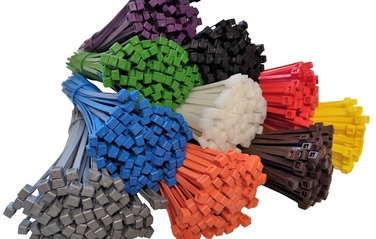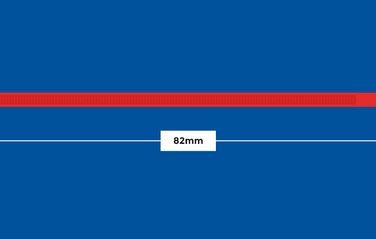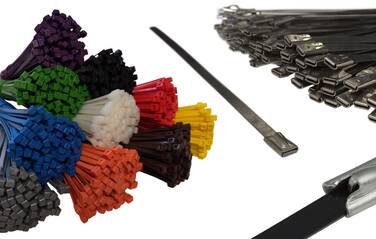Our complete guide to cable ties will tell you everything you need to know about that most humble piece of plastic, that everyone has used at one time or another.
What exactly is a cable tie? As the name suggests, a cable tie is used to fasten things, usually cables or electrical wires, together in a bundle. Working in the same way as a strap to keep cables together neatly, cable ties can be made from nylon or stainless steel. Usually available in a variety of lengths and thicknesses, cable ties can also be referred to as zip ties. The simplicity of the design makes a cable tie extremely easy to use; at one end of the tie, there will be a square head with a hole, into which the other, pointed end is inserted. The majority of cable ties will only work one way – the ridges on the tie will be caught in the teeth on the head to hold it securely in place.
Originally designed in 1958 for use in the aviation industry, cable ties were initially created to bundle together the wiring found inside commercial aircraft, which could run to hundreds of feet. The first cable ties were manufactured from stainless steel, with the first nylon cable tie not being produced until 1968. Today, cable ties are made from nylon, stainless steel and plastic-coated stainless steel. There are also metal detectable plastic cable ties which contain a high enough metal content to be detected by commercial machines.
Types of cable tie and their features
Nylon cable ties – these are usually single-use and are self-locking. Available in various lengths and widths in a choice of colours.
Releasable cable ties – can be reused, making them useful for bundles that need to be added to or removed from.
Push mount cable ties – these have a mounting device which locks into place when inserted into a pre-drilled hole. Integral mounting device so no other fixings are necessary.
Marker cable ties – the same as a standard cable tie but with an integral tag moulded into them that can be written on or have an adhesive sticker applied to it.
Stainless steel cable ties – extremely heat resistant and with a high tensile strength. Will withstand heavier loads than a nylon cable tie.
UV and heat stabilised cable ties – designed for permanent use in outdoor environments. Ideal for use with heat conductive cables.
Screw mount cable ties – these can be panel mounted and fixed securely in place with a screw.
Metal detectable cable ties – these contain an evenly dispersed metal content which allows detection of the smallest fragment by standard equipment. Supplied in a vibrant blue colour to aid easy visual detection.
At cableties-online.co.uk we are also able to offer the following ranges in a printed version, allowing them to be customised with additional sequential numbering: nylon cable ties, UV and heat stabilised cable ties, releasable cable ties and metal detectable cable ties.
Materials used for cable ties
Usually, cable ties are manufactured from nylon, stainless steel or a coated stainless steel. Our nylon 6/6 cable ties are tough and versatile, with resistance to heat and abrasion. They also tolerate fuels and chemicals and can be heat stabilised for prolonged exposure to excessive temperatures.
Our stainless steel cable ties are manufactured from high tensile strength 316 stainless steel and are completely rust and stain resistant. Highly recommended for outdoor use, they can be used in a variety of industries for securing poles, pipes and hoses.
Common applications for cable ties
The cable tie today is used in many areas of industry, as well as having a multitude of uses around the home.
Originally designed for the aircraft industry, the cable tie is still used for efficient cable management on aircraft, with larger, heavy duty ties used for hoses, and miniature ties functioning in tighter spaces. Heat stabilised cable ties are ideal for here too as they are heat resistant.
Similarly, the automotive industry is an area where the cable tie comes into its own. The chemical and heat resistant properties of a cable tie makes it ideal for use under the bonnet, where petrol, oil and grease are present.
In manufacturing and electronics, cable ties offer security in the transportation of components and parts and coloured cable ties can play an important part in organising jumbled wiring. In industries such as mining and construction where harsh conditions are encountered, stainless steel cable ties can withstand high temperatures, extremes of weather and are both rust and chemical resistant. The high tensile strength of nylon cable ties makes them ideal for securing scaffolding netting and sheeting, as well as the actual scaffolding.
Where strict safety laws and contamination risks exist, as in the food production, pharmaceutical and healthcare industries, metal detectable and pre-printed cable ties are essential.
In the home, cable ties can be used in a multitude of situations. Secure cupboard doors to stop inquisitive toddlers accessing cleaning products or simply to keep precious items safe. In the garden, unruly or out of control climbers can be trained up a trellis, as can fruit and vegetable crops as they begin to get taller.
From making domestic life easy on a day to day level (use a coloured cable tie to identify your house keys quickly) to keeping your luggage safe when travelling (pull the zips together and fasten with a cable tie), and organising the miles of cable in your holiday jet, these unassuming items have made themselves indispensable in all our lives.








